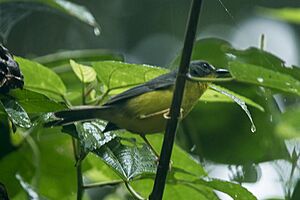Grey-and-gold warbler facts for kids
Quick facts for kids Grey-and-gold warbler |
|
|---|---|
 |
|
| Conservation status | |
| Scientific classification | |
| Genus: |
Myiothlypis
|
| Species: |
fraseri
|
 |
|
| Synonyms | |
|
Basileuterus fraseri |
|
The grey-and-gold warbler (Myiothlypis fraseri) is a small, colorful bird. It belongs to a group of birds called New World warblers. These birds are known for their bright colors and active lives. You can find the grey-and-gold warbler in the warm, wet countries of Ecuador and Peru.
This bird lives in special places. Its natural habitats are warm, dry forests. It also lives in moist lowland forests. These are forests that get a lot of rain and are close to sea level. The grey-and-gold warbler was named after a British zoologist and collector named Louis Fraser.
Contents
What is a Grey-and-gold Warbler?
The grey-and-gold warbler is a type of songbird. It is part of the Parulidae family. This family includes many small, active birds. They are often found in the Americas. Many warblers have bright feathers. They also have unique songs.
Where Do Grey-and-gold Warblers Live?
These birds are found in two South American countries. They live in Ecuador and Peru. Their homes are usually in specific types of forests. These include subtropical and tropical dry forests. They also live in moist lowland forests. These areas are warm all year. They also get plenty of rain.
Their Nests and Babies (Reproduction)
Scientists have recently learned more about how these birds raise their young. This information comes from studying their nests. One nest was found in the Jorupe Reserve. This reserve is in southwest Ecuador. It is managed by a group called the Fundación Jocotoco. This group works to protect nature.
When the nest was found, it had two young birds inside. These baby birds already had many feathers. The adult warblers fed their babies very quickly. They would feed one baby, then the other, right away.
What Do Their Nests Look Like?
The nest found in Ecuador was shaped like a dome. It had a small entrance on the side. The birds built it into the side of a steep ravine. A ravine is like a small canyon. The nest was tucked under a climbing plant called a liana. This made the nest hidden and safe. The top of the nest was even with the ground.
When the young birds were ready, they flew from the nest. They left the nest cup and flew out of sight. This is called fledging.
Another Nest Discovery
Another nest was found in northwest Peru. This was in the Tumbes Reserved Zone. This area is also a protected natural space. This second nest had four eggs. The eggs were creamy white. They had pinkish-orange and red-brown speckles. These speckles were mostly at the wider end of the egg.
Like the first nest, this one was also built on a steep slope. It was tucked into a natural dip. This dip was at the bottom of a Chrysophyllum tree. This type of tree is common in warm climates.
What Are Their Nests Made Of?
After the young birds left the first nest, scientists collected it. They carefully took it apart. They wanted to see what it was made of. The nest had two different layers inside. These layers were distinct.
The bottom part of the nest was woven very tightly. It was easy to tell it apart from the top dome. The dome part was woven more loosely. The birds used different materials to build their nest. These included dry grass and dark, bendy fibers. They also used pale fibers. And they used special leaves called skeletonized leaves. These are leaves where only the veins are left.


